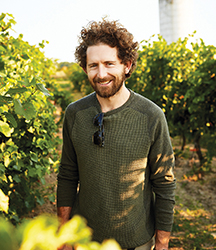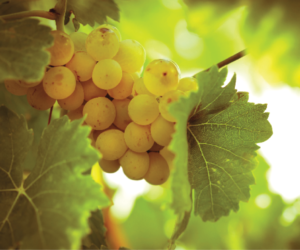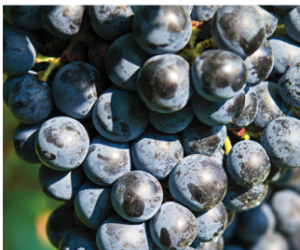From Germany and Alsace, France, to cooler North American climates and Australia, Riesling is popular in cooler climates across the globe. It is known for its high acidity that is often balanced with a bit of sweetness, strong aromas of orchard fruit, flowers, and petrol in some aged versions, and a minerality on the palate. Two pros share how they approach Riesling winemaking.

Dillon Buckley is the Winemaker at Hermann J. Wiemer Vineyard & Standing Stone Vineyards in the Finger Lakes region of New York.
Harvest decisions are focused nearly exclusively on flavor of the fruit prior to picking rather than its chemistry. We, of course, have a target range for sugars that we would like to be at, based on the style of wine that fruit might be going towards, but overall the goal is really to look at fruit expression. For some rough outlines, in our semi-dry Riesling we look to harvest on the earlier side at 18.5–20 °Brix to preserve good, crunchy acids there to balance the natural sweetness that we will retain. For our drier styles of Riesling, we look to achieve higher ripeness but more importantly true site expression. Our reserve dry Riesling and single-vineyard bottlings are more in the 20–23 °Brix range.
We prefer whole cluster pressing for the vast majority of our Riesling (and other white wine) production. The pressing allows for better clarity, retains acidity through the press cycle a little longer, and is a bit more gentle overall. But we do have one Riesling vineyard site planted in 1972 that we tend to destem the grapes from and allow for some soaking on the skins, which we bottle on its own as a single-vineyard offering. We like the impact of the skins in that wine. We do a small lot of fully skin-fermented Riesling as well that goes into a white blend called the Farm White from Standing Stone.
We use a similar approach in our winery as we do the vineyard — considering many factors outside of the chemistry numbers in order to achieve the balance we are looking for. Balance is the driving factor when it comes to making Rieslings for us and that trumps all things. When determining our final blends we rarely ever consider what the acid or residual sugars are. We have some rough frameworks where we know the wine will likely end up based on our continual farming of the same blocks for many years, but we really try to take each vintage of the wines/sites as they are.
Chilling the fermentation is definitely the best way to halt wines with residual sugar and prevent an unwanted restart along with a good dose of sulfur. For home winemakers, I recommend using little to no sulfur prior to halting primary fermentation. A good dose immediately following primary can do the trick. But definitely even using the ambient cooler temperatures in a garage or just outside if you live in an area where you get cold temperatures will work.
All of our wines are wild ferments. It is a critical element to our overall process from vineyard management to pressing and racking. If you were to pitch a commercial strain, use as neutral of a yeast (flavor-wise) as possible.
We keep the fermentations in the upper 50s to lower 60s °F (mid-teens °C), trying to keep tanks from getting too much above 69 °F (21 °C). We used to focus more on keeping things slightly cooler during fermentation but have found that there isn’t a huge difference for our production with slightly warmer temperatures during fermentation. We do end up running quite long primary fermentations due to the cooling of the cellar come November, so often we will have some of our later-pick Rieslings ferment into the late spring/early summer. They go to a period of semi-dormancy in the winter months, which is a bit scary but with a lot of experience we’ve come to trust the wines!

David Paterson is the General Manager and Winemaker at Tantalus Vineyards in Kelowna, British Columbia.
We pick based on how the grapes taste. I like to pick when the Riesling is in the ripe citrus flavor realm, which in my vineyard is around 22–23.5 °Brix with 9–11 g/L titratable acidity (TA) and a pH well under 3 (often still 2.75–2.9).
Immediately after picking I whole-bunch press. I’m looking for the purity and minerality of Riesling and I find skin contact hides that. Though you do gain other qualities with some skin contact, I prefer Riesling with little to no skins.
I inoculate with commercial yeast because the pH of my site is so low I find if I am making drier styles I can get volatile acidity problems towards the end of fermentation with wild yeast and low pH. My favorite strains include Anchor Alchemy 1, Anchor Vin 13, Renaissance Bella, and SIHA 7 from Begerow. Fermentation is done cold, between 48–57 °F (9–14 °C) depending on the rate of sugar drop.
I don’t aim for a final chemistry as I think that hinders the wine finding natural balance. Instead, I do it all by taste and then find out the chemistry afterwards. In general, for our flagship Riesling we are between 12–18 g sugar and 9.6–11 TA at bottling. To halt fermentation and leave some residual sugar I rely on cooling, but if you can’t hold a stable temperature between 25 and 32 °F (0 and -4 °C) then a timely SO2 addition and keeping the wine as cool as possible is your best bet.
In addition to our flagship Riesling we have our Riesling Lab series that allows us to experiment each year with hard-pressed juice. The pH is a lot higher in this juice so we often adjust down a little with acid. The juice is more phenolic when extracted at higher pressure, so we hyperoxidize the juice and ferment wild in old Chardonnay barrels. These types of experiments are fun and something home winemakers can also learn a lot from.
Other advice for amateurs is to pay more for high-quality juice. Grape quality and harvest timing are 80% of what determines great wine.






